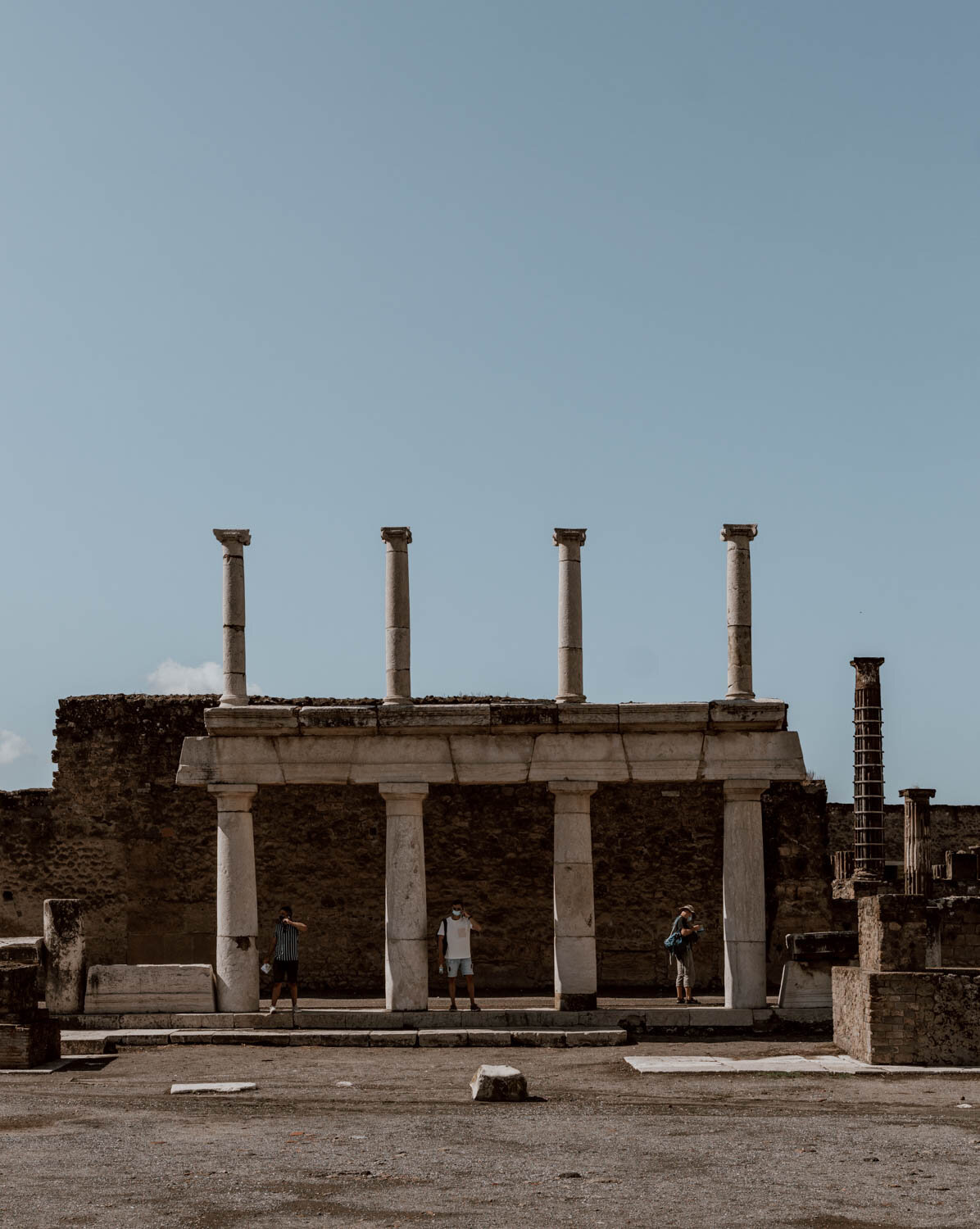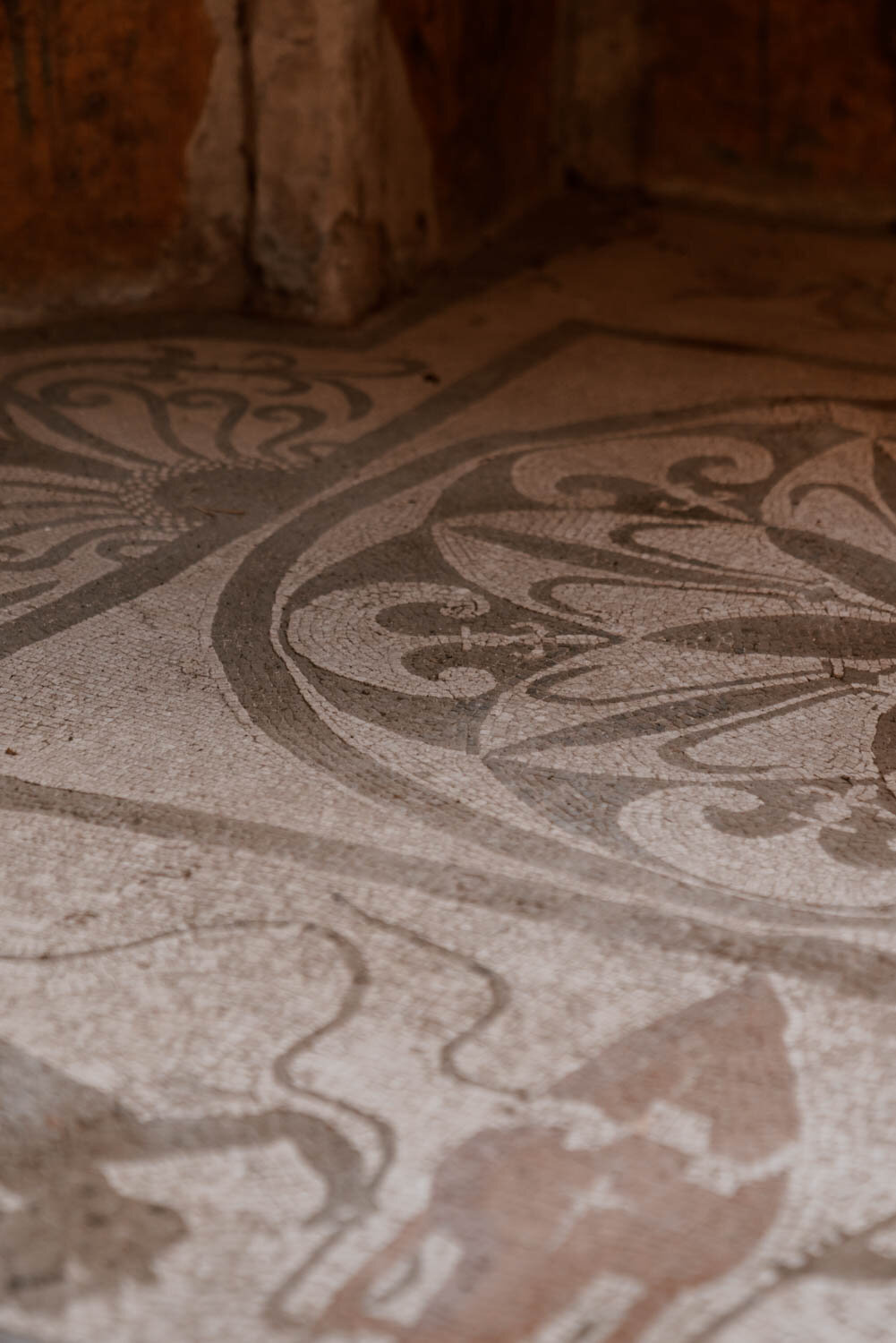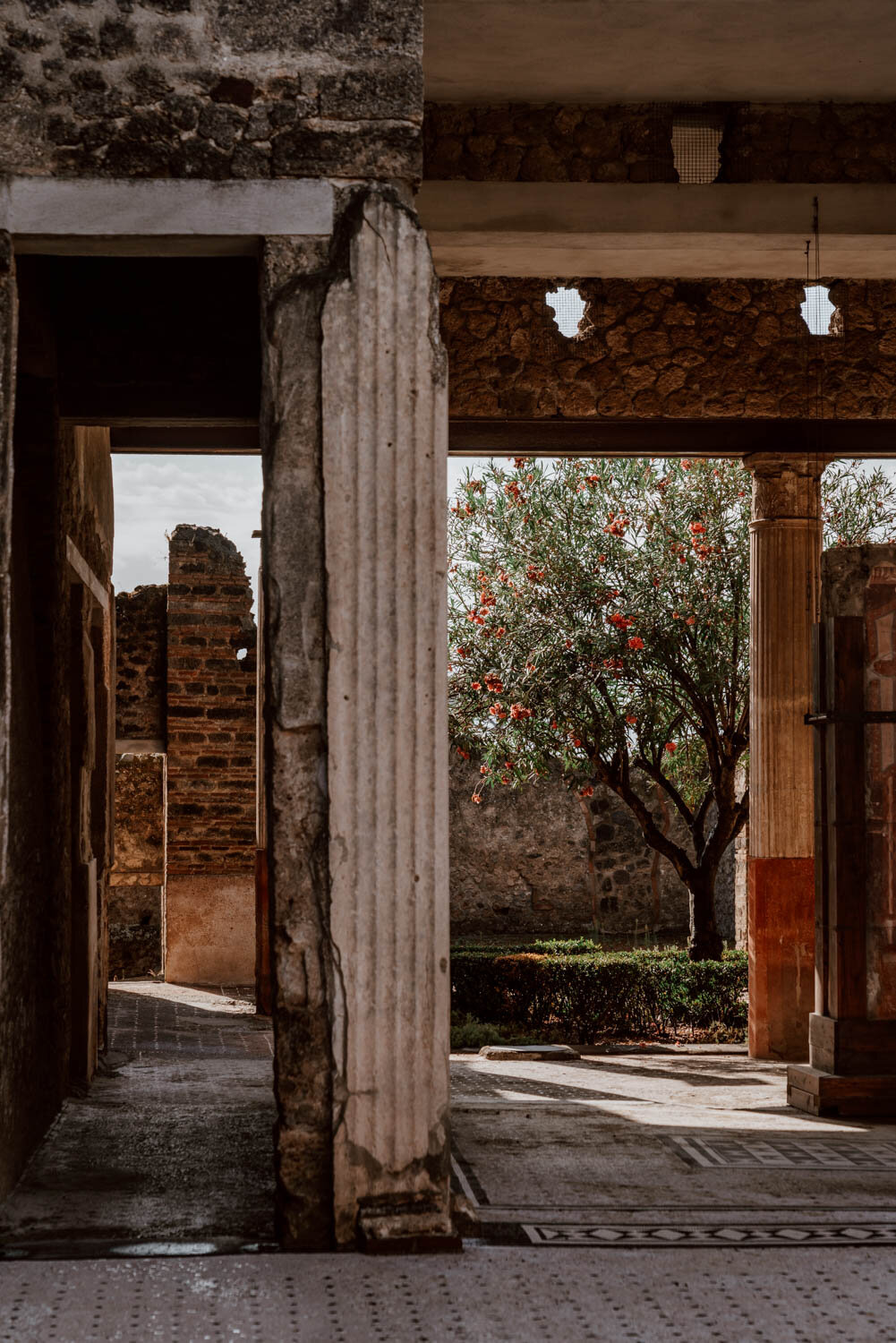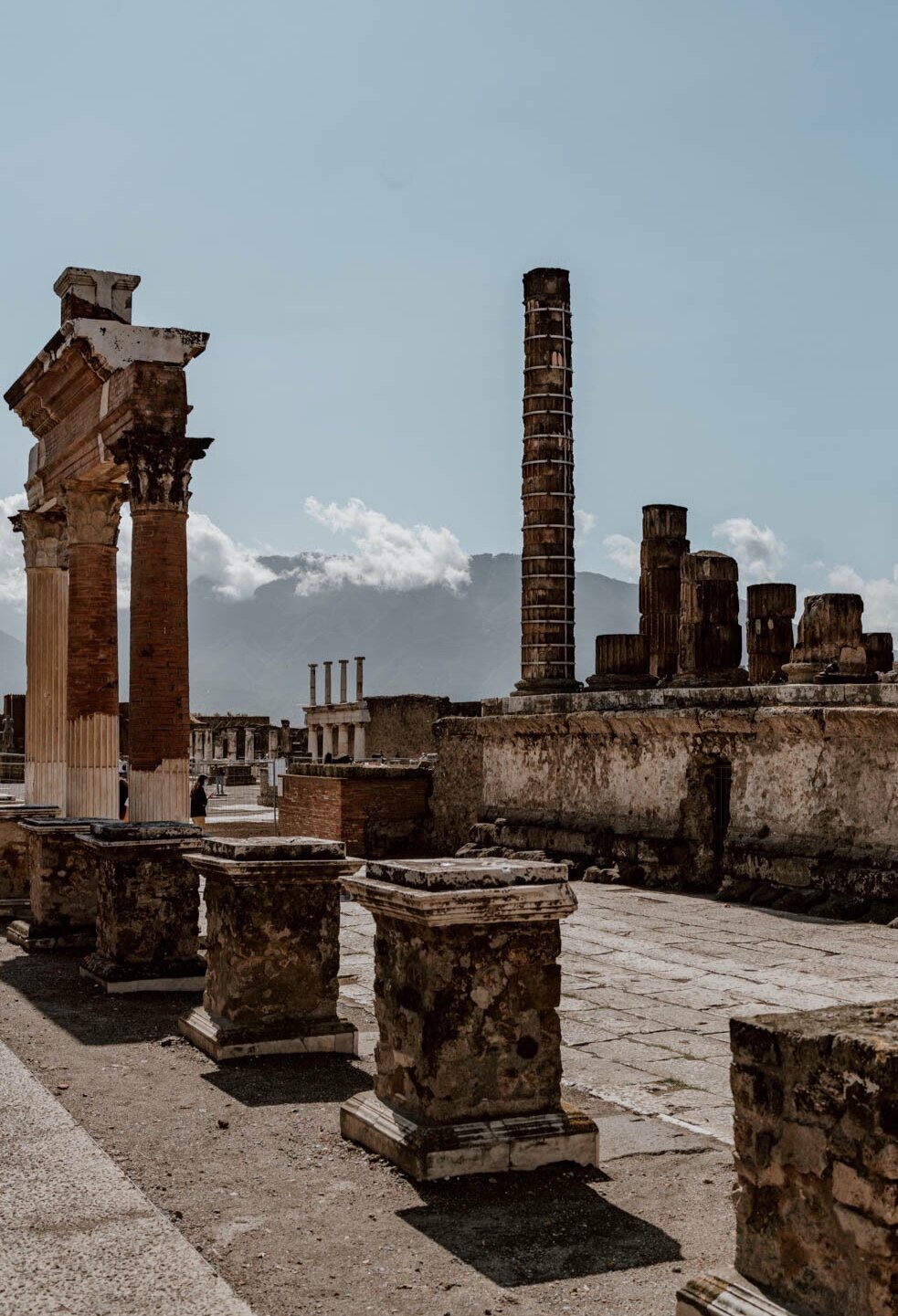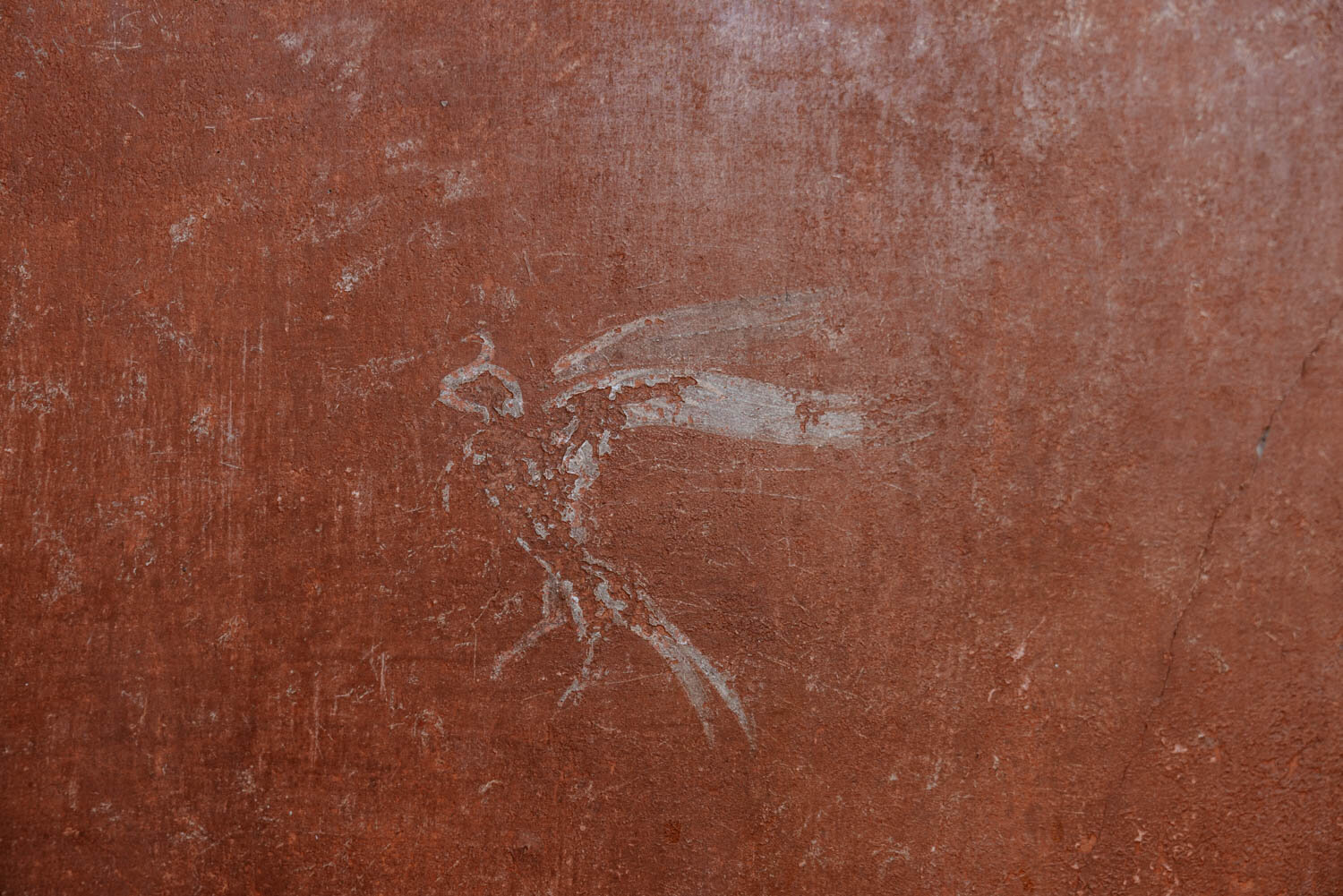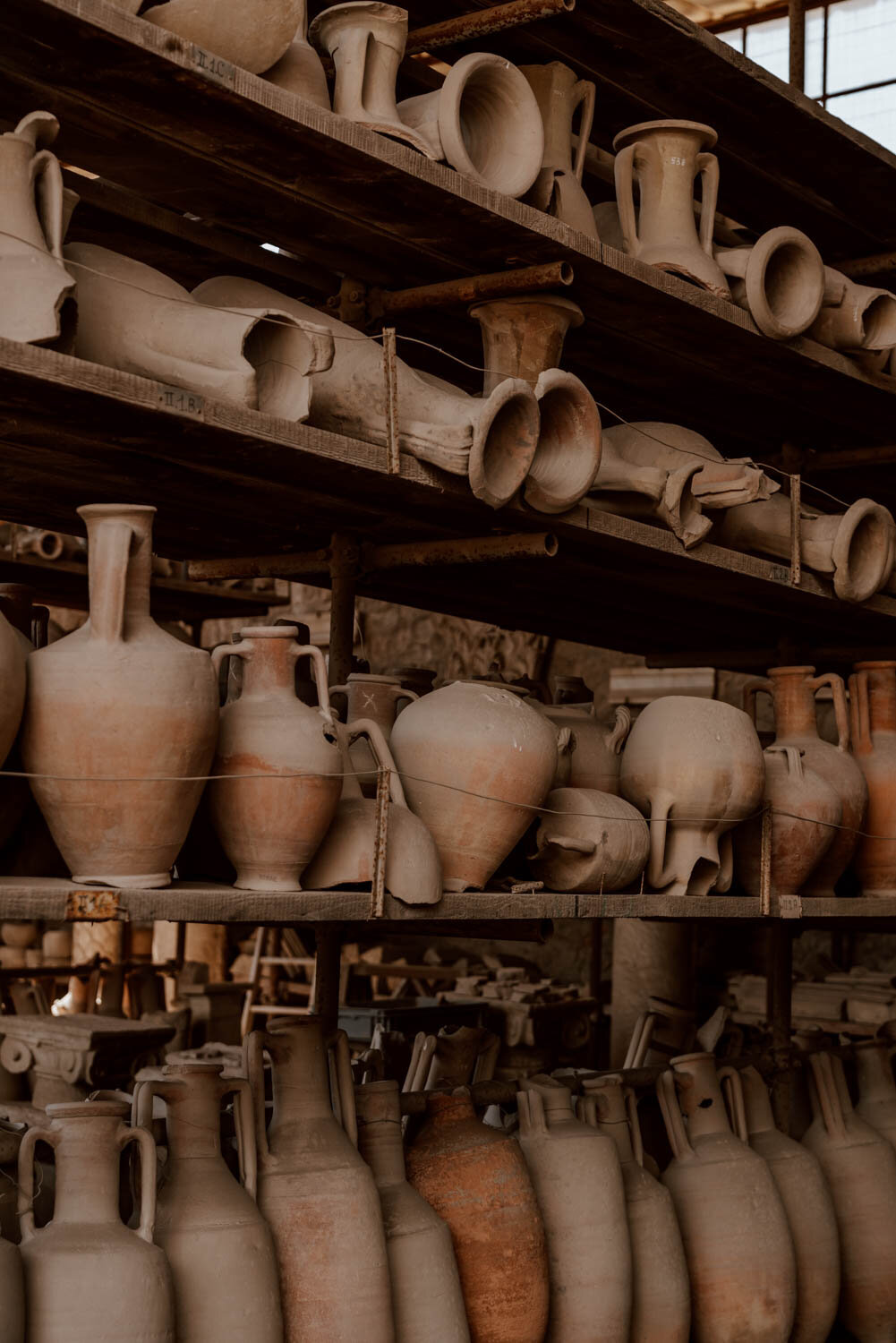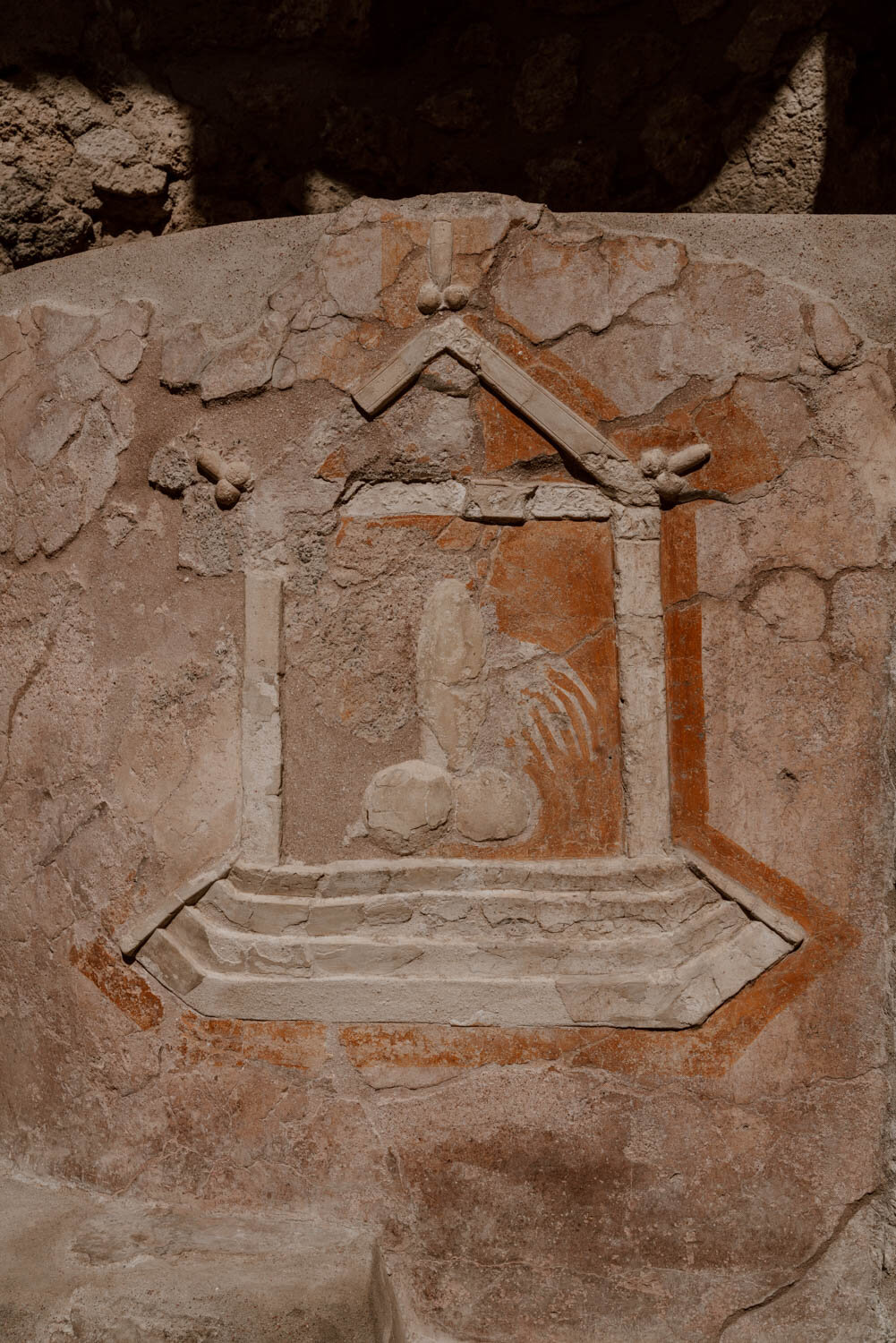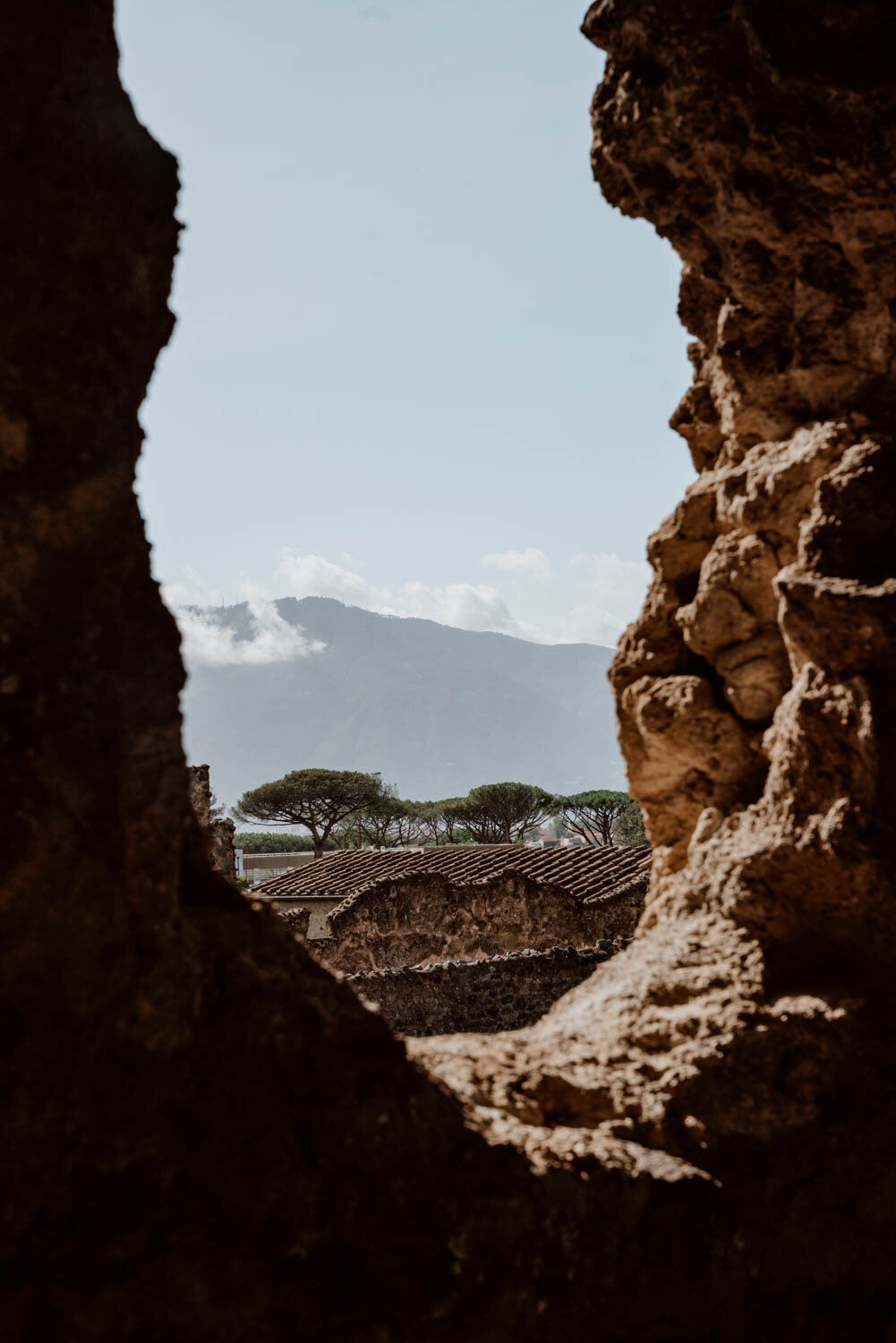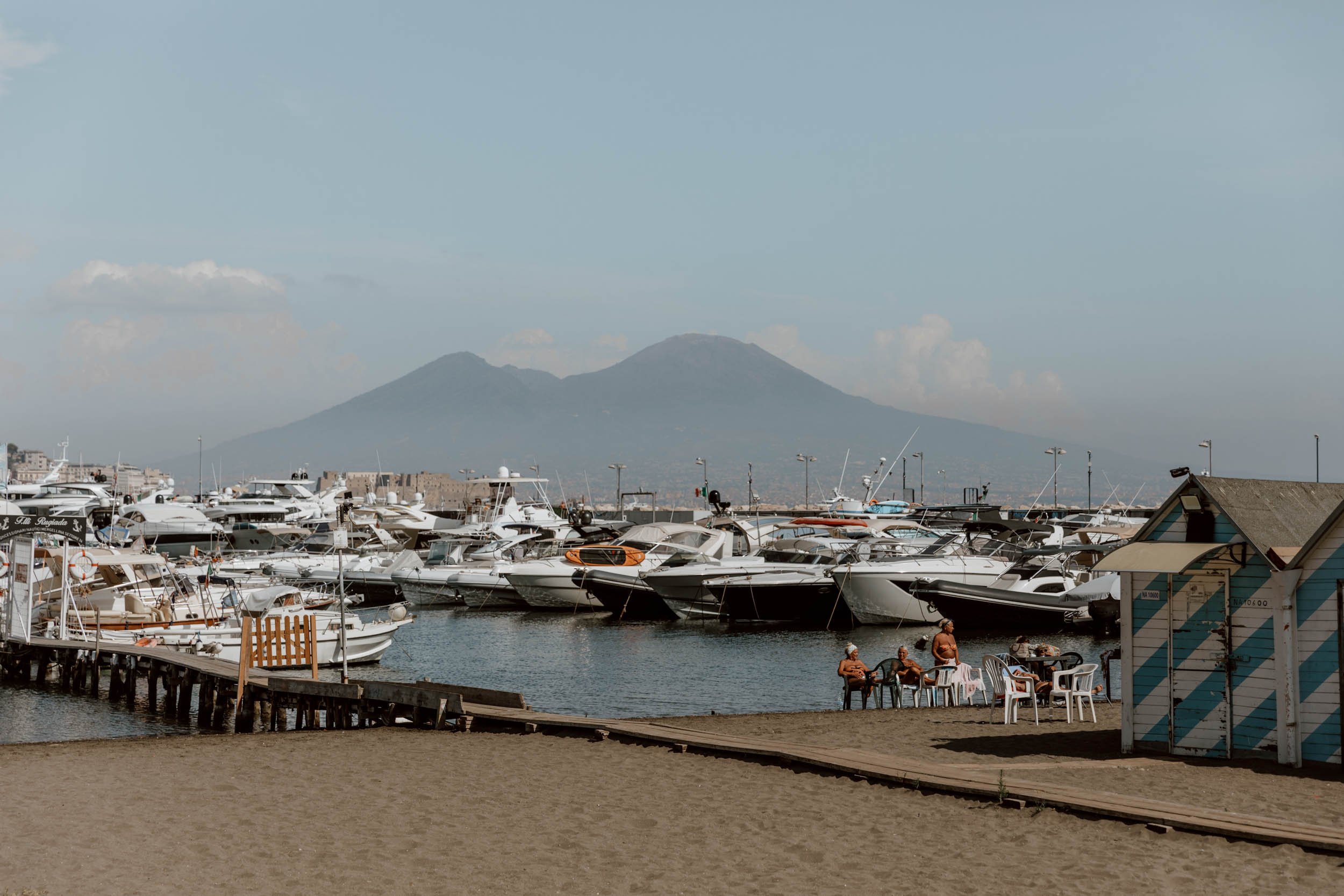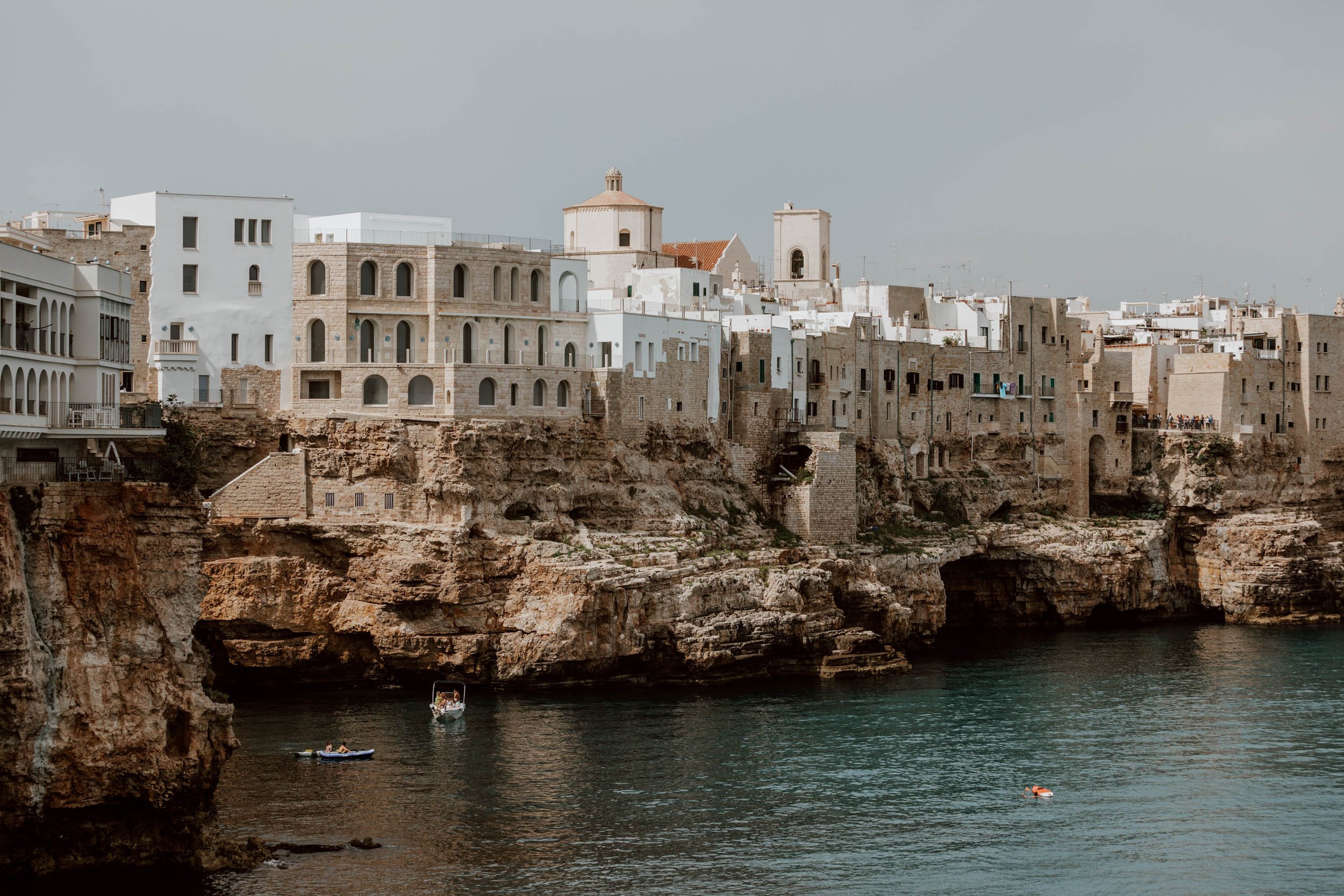If you're planning a visit to Pompeii, one of the world's most important archaeological sites, our article will help you to get started and get sorted.
Article fully updated with summer 2024 visitor + ticket information.
It must have felt like the world was ending.
Before the skies turned black on that fateful day in late summer or early autumn, there had been warning signs of what was to come in this town of traders not far from the shore. The mountain which loomed over the bay, long restful, had started to rumble with the discontent of a fever dream.
Pompeii was not the grand court of Emperors or a citadel of tyrants, but rather a place of busy streets, rowdy taverns and normal people who broke bread with family and simply dreamy of what tomorrow would bring. Most read the runes and departed by land or sea as the growls and tremors of their mountain deepened.
Others did not not, through choice, necessity, infirmity or stubbornness.
And then Mount Vesuvius awoke.
In a rage which would echo through the centuries, fire and brimstone ripped from its pitted depths and tore toward the heavens. The atmosphere turned into a fatal pressure cooker thick with heat, gas, and fury. Rocks fell like rain.
The left behind people of Pompeii - its lovers and rivals, its merchants and slaves, its rich and its poor - had no chance.
And yet, the very act which destroyed Pompeii with such callous, brutal efficiency under an avalanche of ash and stone, would preserve it for the ages.
The stories of this Roman town not far from the shore would never die.
//
Pompeii's survival over nearly two millennia makes it one of the most important sites of historical, archaeological, and human significance in the world; it’s also Italy's second most-visited attraction.
This post isn't about overwhelming you with all the intricacies and intrigue of Pompeii though; it's about giving you the essential, practical information you need to plan your own visit, alongside tips to enhance your experience and a curated selection of resources which really brought the story and significance of Pompeii to life for us before our own visit last summer.
We’ll also explain why the Romans were so fixated on penis ornaments.
So, if you're unsure whether you need a day or longer, don't know where you need to stay before and after Pompeii, or just need some clear advice on tickets, transport from Naples or Rome, what to bring, routes to follow, and avoiding the crowds and scams, this article has all of the answers for travellers like you.
We've also included our personal picks on the sights in Pompeii you simply have to make time for!
Here are 17 essential things to know before you visit Pompeii, Italy.
(In a rush? It’s highly recommended to book your Pompeii ticket in advance online before you travel, especially if visiting during high season - book your Pompeii ticket here.)
the pompei essentials
History / Destroyed in 79 AD, discovered in 1748.
Summary / A Unesco World Heritage site in southern Italy, 14 miles from Napoli.
Price / €19 entry per person, online ticket purchase recommended.
Time / Requires at least a full morning or afternoon, plus comfy shoes.
More / Possible to pair with Mount Vesuvius or Herculaneum
Discover / Learn more about Pompeii by taking a tour - this one with an archeologist is highly rated
What Happened to Pompeii
Mount Vesuvius (Vesuvio in Italian) towers over the Gulf of Naples. The volcano is thought to have lain dormant for 700 years before its eruption in 79 AD, and various settlements had grown at its foothills. The fertile soil of Campania, the proximity to Naples, and the access to the sea would have made it a pleasant and prosperous place to live, work, and trade.
All was destroyed in a day or two.
Despite taking place nearly two thousand years ago, it was the gift of the eyewitness testimony of Pliny the Younger, who watched from the beach as his uncle staged a one-way rescue mission across the sea, which traced the natural disaster to 24th August 79 AD - recent findings suggest the eruption may have occurred a few months later.
Regardless of the season, the events of that day killed around 2,000 inhabitants and as many as 16,000 elsewhere within the Gulf of Naples. Lava and fire isn’t usually talked about in relation to Pompeii, but rather a black storm of ash and debris leading to pyroclastic flows down the mountain: “a superheated hurricane-force wind carrying ash and rock that can destroy almost anything in its path”
If the the heat didn’t get you, then the wall of ash and toxic gas would suffocate and poison; either way, it was instant death.
Pompeii, before anything else, is a site of human tragedy.
Yet, it’s really important to note that it was a minority Pompeii’s citizens who perished. Those were the ones who stayed, didn’t heed the warnings of Vesuvius’s rumblings, or simply couldn’t pack up and leave quickly like an estimated 17,000 or so others did in the previous days.
When Was Pompeii Discovered?
The town of Pompeii was left buried for seventeen centuries - impervious to the fall and rise of empires, the climate, and the shifting sands of time and civilisations. They were not always forgotten though, with their correct location being marked on a map in the 12th century.
An architect, Domenico Fontana, is considered by most to have been the first person to have properly rediscovered Pompeii during the course of his aqueduct tunnelling work in the late 1500s. For one reason or another though, he seemed to be content with making a quick note of this, covering it back up, and continuing his quotidian work.
Pompeii is therefore generally regarded as being properly rediscovered in 1748, ten years after excavation work had begun at Herculaneum - a smaller town down the road which suffered the same fate. Collectively, these projects are widely viewed as starting the modern science of archaeology, and efforts were aided by the debris being generally loose and relatively easy to remove.
Unfortunately, various periods of excavation with nascent techniques or a lack of understanding around preservation caused irreparable damage in parts, as well as opening up the fragile buried treasures of Pompeii to looters and vandals.
By the 1990s, about two-thirds of the site was uncovered using improved systems, technology, and methods; as we explain later in this post though, Pompeii was long a byword for chronic neglect underfunding, and archaeological mismanagement.
Why Is It So Important?
There are, after all, many Roman ruins and monuments scattered across Italy and Europe. In Verona, you can still listen to opera every summer within a stunning Roman amphitheatre. In Rome, we all gaze in wander at the Colosseum. And in Sicily, there are ruins which are much, much older than anything the Romans did here.
The importance of Pompeii is therefore not simply because of its age, its fate, its size, or its rediscovery; it’s because of how normal it was.
“If Naples had been buried we would have discovered much better quality jewellery, frescoes and mosaics, because it was a richer city with a real aristocracy. But that would have given us a completely distorted idea of what life was like. These places are special because they’re ordinary. If Herculaneum and Pompeii were more important to the Romans, they’d be less important to us.”
Paul Roberts | Curator
Though the public buildings and temples of Pompeii are incredibly important, it’s the intimate insight into hundreds of homes, businesses, and lives of ordinary citizens of Ancient Rome, fantastically preserved* at scale underneath those layers of rock and ash, which set it and Herculaneum (more on that later) apart from any other relic or ruin of the age.
Nowhere else was preserved quite like this, and nowhere else like these sites exists in Europe.
Collectively, the archaeological areas of Pompei, Herculaneum and Torre Annunziata were designated a UNESCO World Heritage site in 1997.
From its buried treasures, historians and archaeologists have been able to piece together much of the society’s tastes, diets, art, hierarchies, lusts, and generals ways of life. And it’s precisely because Pompeii was just a normal place in Ancient Rome, not the grand citadel of Emperors or generals, that makes the stories it reveals so rare and valued.
When walking the streets of Pompeii and standing within its rooms, remember that you are standing somewhere that should have been long lost to nature and time, these are actual Roman streets and Roman buildings; the town itself was literally buried treasure for over 1,600 years!
* ‘Frozen in time’, for understandable reasons, doesn’t seem like the appropriate term…but you get the picture.
Pre-Visit Inspiration
You will enjoy your visit to Pompeii much more if you invest a little time beforehand reading up on it.
We always do this before visiting any ruins as, without that colour or background knowledge, the chances that it may be a dull few hours vastly increases. There are people far better qualified and entertaining than us to bring Pompeii to life for you, and to explain just how significant the site and its treasures are before you personally explore them.
We watched, read, and listened to the below (mostly free) books, documentaries, and podcasts during our seven-week Italy adventure , and highly recommend making time for at least one of them before your own trip to Pompeii (they’re perfect for the plane journey or downtime!):
Pompeii Live from the British Museum | If you watch one thing before your visit, make it this. The British Museum’s 2013 Pompeii exhibit broke records, and this documentary about it originally aired in cinemas. It’s now free on Youtube, and sees several classicists and archaeologists discussing the site in an accessible, engaging, and entertaining manner. Not recommended for under 12s (they talk a lot about sex, penises, and a horny goat…sometimes all at the same time).
Pompeii: The Life of a Roman Town | Mary Beard is a bit of national treasure in the UK, and she features in the above documentary as well as being the author of this great book on Pompeii. It was also made into an hour-long BBC documentary, which you can currently watch for free here.
Pompeii by Robert Harris | This definitely slots into the ‘holiday read for Italy; category, rather than being a strictly historical text. However Robert Harris’ historical thrillers are all very good, and this one is equally gripping (as well as giving a lot of accurate insight into what happened before the eruption).
History Extra Podcast | It’s only a 33-minute listen, so there’s no excuse for not giving this a go before you visit! In this podcast episode, historian Daisy Dunn revisits the eruption and the significance of Pompeii. There’s also this one by National Geographic.
There are several movies on Pompeii, most recently including the ingeniously titled ‘Pompeii’ featuring Jon Snow (from Game of Thrones, not Channel 4 News). Alas, for what it has in CGI and a bombastic score, it lacks quite a bit in historical accuracy (it’s also a bit of a Gladiator rip-off). Still, not a bad startpoint to get some inspiration!
All Road Lead To Naples (Sort of)
The ancient ruins of Pompeii are situated next to the modern town of Pompei (note the crafty dropped 'i' to distinguish between the two) in the southern Italian region of Campania.
Technically, you’ll be visiting the ‘Pompeii Archaeological Park’ (Google Maps)
The charming, chaotic city of Naples (Napoli) is just 14 miles away and the most popular base from which to visit Pompeii. From the city, it's possible to make your way to the site independently via the train in under an hour and it's also the departure point for lots of highly-rated small-group or private tours of Pompeii.
It also means you can have the world's best pizza for dinner after a day of exploring one of its most famous sites.
We've included all the necessary information and costs on how to get from Naples to Pompeii in this post. Be fully aware in advance that pickpocketing on the main train route, given the high numbers of tourists, is very common.
Read | How To Get To Pompeii from Naples
Alternative places to stay
We adored Naples - a city which is really like no other in Italy or Europe - but many people who arrive with romantic allusions are little…taken aback… and don't really know how to navigate or enjoy it. If Naples doesn't sound like your cup of tea, then you can choose to visit Pompeii from a few other places in the Campania region:
Amalfi Coast | One of Italy's most famous destinations, it's got all those quintessential dolce vita vibes in summer. The popular towns of Sorrento, Amalfi, and Salerno all have direct transportation to Pompeii. However, these are very popular holiday towns in their own right and have a price tag to match.
To travel between the two, simply hop on the regular Circumvesuviana train from Sorrento to Pompeii Scavi, the station outside the ruins. Trains run twice every hour, travel time is 30 minutes, and it’s €2.10 per person.
Pompei | The town right next to the site offers up much better value accommodation than the Amalfi Coast. If you plan on spending more than one day in Pompeii (note the extra 'I'), visiting other archaeological sites in Campania, or taking day trips along the Gulf of Naples then this is a sensible option given the proximity and transport connections. From what we experienced in our brief walk around the central piazza, it was quite pleasant too.
Torre Annunziata | Similar to the above, but this one is more of a Plan C in case you can't find anything that suits your travel budget or style in Pompei.
Ercolano | Half-way between Naples and Pompei, this is the home of the secondary, lesser-visited town which was also destroyed by Mount Vesuvio, and is therefore an option for those who may wish to visit it, as well as take day trips to Naples, Pompeii, the Amalfi Coast.
If you're visiting Pompeii as part of a longer southern Italy road trip, we do not recommend basing yourself in Naples. Instead, Pompei or Torre Annunziata would be much more convenient for you and your parking/driving sanity. If you’re simply dropping in for the day, there is also paid parking close to the site itself which we've included further details on later in this post,
If you’re planning on visiting Pompeii on a day trip from Rome, then you have to plan your time a little differently and with a tad more precision than if you’re based in or around Naples. We’ve shared everything you need to know in this post: How To Travel Pompeii from Rome in One Day.
Keep Reading // Looking for more inspiration for your Napoli itinerary? Hope on over to our guide on the best day trips from Naples.
How Long Do You Need for Pompeii?
If you're still in the planning stage of your Italian itinerary, we'd recommend setting aside a full morning or afternoon for Pompeii, regardless of where you're basing yourself in the Campania region.
The site is open from 9 am to 5 pm (November to March), and 9 am to 7.30 pm in high season (April to October). Last entries are 90 minutes before closing.
The area to cover is large (163 acres), spread out, and involves a lot of walking; even a 'quick' independent visit would take a couple of hours. However, there's little point in coming all this way to rush around. We spent four and a half hours exploring Pompeii at a sedate pace, taking photos, getting lost (this is inevitable), and having a few breaks along the way.
The diminishing returns of ruin fatigue is always a thing to bear in mind too.
Indeed, some people may look at our four and a half hours as nowhere near enough time to truly appreciate Pompeii or its significance! There are travellers who come to Pompeii for two or thee days in total due to their keen interest in the ruins, or base their entire Italian trip around the varioius archeaological sites in the Gulf of Naples.
For the majority though, we think 3-5 hours will probably also be your max, making it an ideal day trip activity from Naples or the Amalfi Coast. Much longer than that, especially on a hot summer’s day, will see your interest start to wane and your energy sap.
The majority of guided tours, including this highly-rated one with an archaeologist, last two hours and then leave you free to continue exploring on your own.
If you're passionate about Pompeii and visiting it a couple of times, we'd recommend spreading your time over 2-3 days from a nearby base, rather than packing as much as possible into a single visit.
Avoid These Two Common Pompeii Scams
Thousands of tourists visit Pompeii every day, with the majority using the trainline which links it with the Amalfi Coast and Naples.
Unfortunately, this is a known target for organised pickpocketing groups.
Knowledge of this fact should be enough to prevent you falling victim to it. Whilst waiting on the platforms or during transit, keep your daypack on your person and don't have your phone or wallet temptingly stuffed into your back pocket.
However, we also found a surprising number of unexpected 'white collar' tourism scams operating. There are several businesses outside the complex, along Via Roma and by the two main entrances as well as outside the train station, staffed by reps in brightly coloured t-shirts that repeatedly insist that that entrance is closed today or that they're the place to buy your ticket, get your audioguide, hire a tour guide, or find a shuttle bus. Now, the hard sell tactics aren't too bad, and some of the services offered are absolutely legitimate, but we knew they were telling visitors several bare-faced lies to try and make a sale.
Therefore, be sceptical of what they say as you pass, no matter how convincing they sound.
Know Your Entrance
There are three visitor entrances to Pompeii, and which you enter often depends upon how and where you arrive. The important thing to note however, is that whilst your chosen entrance will shape the route you follow initially, none will make a significant difference to your enjoyment of the site.
Porta Marina (via Villa dei Misteri) | The likely option if arriving by train from Naples, this entrance is just a couple of minutes' walk from the station. Outside, you'll find a handful of small cafes and restaurants at the roadside for breakfast, lunch, or snacks. Find it here on Google Maps.
This entrance brings you to the Temples of Venus and Apollo first. You can find parking at Pompei Scavi Parcheggio (Map) or Pompei Parking Zeus (Map)
Piazza Anfiteatro / Piazza Immacolata | This entrance brings you to the Ampitheatre and Garden of Fugitives first. If you're staying in Pompei, then it's a short walk from the old town centre, so a sensible start point. Find it here on Google Maps.
On Via Roma outside, you'll also find a big selection of restaurants for lunch as well as the EAV bus to Vesuvio, so we actually recommend exiting here for those of you adding that on to your day trip.
If starting your Pompeii visit here, note that this is the entrance which does have most of those misleading businesses mentioned above.
There's a small blue zone car park across the road, but your best bets are at Pompeii Parking Soc. Coop (Map) or Eden Park Games (Map).
Piazza Esedra (piazza Porta Marina Inferiore) | This entrance is best if you're arriving by rental car due to the number of private parking lots available just across the road. The €10 all-day parking available at Pompeii Parking is the one to make a beeline for though.
The facilities for restaurants etc are limited at this entrance, but there are still a few options (plus an abundance of souvenir stands given this is the main area for large tour buses to drop off).
Parking around Pompeii costs anything from €10 per day to per €5 per hour, and capacity is limited.
it’s still recommended to Buy Your Pompeii Tickets in Advance
The good news is that changes and visitor limitations that were brought in during summer 2020 have now been completely removed, and things are pretty much back to normal. This means that whilst it is highly recommended to buy your tickets in advance (especially if you’re visiting Pompeii during the busy summer months), you are once again able to buy tickets at the entrance gates.
There are three ways to secure tickets to Pompeii:
Pompeii Tickets Online
The official Pompeii website does not sell tickets, but rather directs people to purchase from TicketOne.it, which is the only authorised online retailer for tickets.
There are two types of ticket avaialble: ‘Intero Pompeii Express’ and ‘Intero Pompeii Plus’.
Most people will be buying the Express ticket which covers the ruins, but if you’d like to visit the suburban villas (Villa dei Misteri, Villa di Diomede, and Villa Regina at Boscoreale), you’ll need to purchase the plus ticket.
Prices from January 2024 for the standard / Express ticket are:
€19 per person for a one-day ticket
€2 for EU citizens aged from 18 to under 25
Children under 18 enjoy free admission too (unfortunately it’s really unclear if this applies to EU citizens only)
Note that additional 'pre-sale' online charge of €1 per ticket has now been folded into the overall cost for ‘full’ tickets.
Disabled people and their carer are entitled to free tickets, but under the current system free tickets these still have to be purchased and reserved on this specific section of the TicketOne website. For any concessions or free tickets, you may be required to show ID or proof at the entrance.
With these advance online tickets, you can skip the queue and go straight to the electronic scanner barriers. Therefore it's always best to have a copy downloaded to your phone before you arrive and make sure you’re there 10-15 minutes before your slot begins.
If you already know your travel dates, it’s sensible to book as soon as possible to ensure you get a suitable timeslot; we entered at 9 am so that we could enjoy some precious moments with the site at its emptiest.
Buy your Pompeii ticket here.
The official ticket site will initially load in Italian, but should revert to English automatically. If not, just click the little globe icon on the top right side and select English.
After selecting your timeslot and paying with card, you’ll receive email confirmation and e-tickets.
Buying Tickets at the Gates
It is also possible to buy on the day at the ticket offices outside Pompeii, found in in Piazza Esedra and Piazza Anfiteatro. However, do note that that with limits on overall numbers, this option does potentially mean access won't be permitted for the time you expect or arrive. Also, please make sure you are purchasing in person from the official ticket kiosks - at the Pompei Scavi train station there are people trying to bring you to a non-official ticket office.
Pompeii is free to enter for everyone on the first Sunday of every month under the ‘Domenica al museo’ scheme, but in order to prevent overcrowding which could put the safety and protection of both the site and visitors in jeopardy, and to optimise visitor flow, should the number of visitors exceed 15,000 by 12 pm, the ticket offices will close for an hour.
The free ticket for a single access must be requested on the official website or at the physical ticket office.
Skip-The-Line Tours
A guided tour around Pompeii will really help to bring the history to life, and your most convenient option is to book this in advance online too.
The good news is that the vast majority of private or small-group tours available, either departing from Naples or meeting at Pompeii, include a skip-the-line entry ticket within the overall price.
Two birds, one stone and all that.
You can find and book a selection Pompeii tours here, but we’ve selected the best ones in the next section.
Should You Get A Guide for Pompeii?
It depends.
We didn't get one because, well, we've found that a tour guide can sometimes prove more restrictive for us than we'd like. We like to do lots of our own research and reading before visiting ruins, and don't like to have to rush taking photos or savouring something that captures our curiosity. Also, the experience of having an underwhelming and slightly dull tour guide in control for a couple of hours is enough to sour the experience of any place (trust us on that).
However, our approach isn't necessarily the best one for visiting Pompeii.
For a site as vast and steeped in history as this (the significance of which in certain parts which doesn't immediately reveal itself to you), a good tour guide could be essential to helping you to appreciate why on earth Pompeii is so special and the tragedy which unfolded here in 79 AD. It must be said that we found the explanatory signs around Pompeii to be severely lacking (both in number and storytelling), and it would be very easy to miss certain treasures or overlook key sections if you only have a few hours. A guide will also help you navigate the site and its various interconnected ‘regio’ too.
If you’re not going to do lots of reading or research before you visit, then a guide is a necessity.
Yet, there's no getting away from the fact that some tour guides are incredibly dull and, if you get a dud, their dry explanations or lack of ability to answer your questions can kill an experience stone dead. Within Pompeii, we certainly heard a few of the former, but there were also a handful of enthusiastic, engaging storytellers leading small groups around.
So there’s always a risk.
If you would like to book a guided Pompeii tour, the following are all highly rated and well-priced, so would be a good start point. We recommend booking a tour which meets you at Pompeii, rather than includes transport to/from Naples, as this opens up better options as well as more flexibility for what you do after the tour ends!
Small-Group Pompeii Tour with an Archeologist | This two-hour tour is led by an archaeologist and has absolutely incredible reviews. Your ticket is included in the price, and you meet at the entrance. It’s also possible to book the archaeologist for private tours around Pompeii. Find out more or book here.
This tour is also available to buy on Viator.
Pompeii Ruins Skip-the-Line Tour | Another very well-reviewed tour, the group here is limited to a maximum of 20 people. Find out more or book here.
Unveiling the Buried City Tour | This three-hour walking tour, with a maximum 15 people, has fantastic reviews and offers an excellent in-depth introduction to Pompeii and its stories. Your ticket is included in the price. Find out more or book here.
Half-Day Pompeii Tour from Naples | This tour is an option for those who wish to have round-trip transportation and hotel pick-up from/to Naples included, as well as their guided walk around the site. However, this will not be suitable if you want to spend longer exploring Pompeii independently after the tour ends. Find out more of book here.
There are also licensed guides outside the site at the Piazza Anfiteatro and Piazza Esedra entrances - however this does mean you have to take your chances with the person who's available there and then. There are also plenty unlicensed guides, so make sure to double-check before agreeing to join their tour or handing over money.
You Can Pair It With Mount Vesuvius...
Before you set your Pompeii day trip plans in stone however, we need to talk about Mount Vesuvius.
There's a (quite) regular public bus between the two sites, as well as a number of combined tours and shuttle buses, making it perfectly feasible to visit the cause of Pompeii’s destruction after the ruins
We chose to do it the cheap way, taking the bus up the steep, winding roads to the crater after our morning in Pompeii and a quick lunch.
We've shared all the details on transport, costs, and practicalities in 'How To Visit Pompeii & Mount Vesuvius in One Day'.
However, if you’d prefer someone else to take care of the logistics and transport, this full-day tour combines both sites, and includes pick-up and drop-off in Naples, lunch, an English-speaking guide, as well as entries to both Vesuvius and Pompeii.
...Or Herculaneum
If ruins or Romans ain't your thing, it may come as a surprise to learn that there is a site just down the road, which suffered the same fate and is better preserved, but sees a fraction of the visitor numbers.
Herculaneum, 10 miles away, is smaller than Pompeii and far less famous.
However, this sister site is heralded by classicists and archaeologists as just as important.
We simply felt that spreading ourselves across two ruins in a single day* would not be sensible or enjoyable (one ruin would ruin the other, one may say...). We didn't want to rush Pompeii, didn’t want to skip Vesuvius, couldn’t spare another day from Naples, and nor did we want to arrive to Herculaneum with 'ruin fatigue'; we decided to save her for a future trip to the Amalfi Coast.
Your travel style and tastes may lead you to the complete opposite decision, and that's perfectly fine! However, if visiting both Pompeii and Herculaneum, we'd certainly recommend considering spreading your visits out over two days rather than one.
To visit Herculaneum (also called Ercolano), simply hop on the train once you’re finished in Pompeii and get off at Ercolano Scavi. Two to three hours is generally viewed a good amount of time, but note that last entries to the site are at 6pm in summer (April to October) and 3.30 pm in winter (November to March).
Tickets are €13 per person or €2 for EU Citizens aged 18-25, As it’s much less busy, you can buy tickets on the day - you can find more information on the official website for the Parco Archeologico di Ercolano,
Plan | Guide To Visiting Herculaneum Ruins
Can you visit Pompeii, Vesuvio and Herculaneum in one day?
Logistically and theoretically, this is absolutely possible but we would strongly advise against it.
If doing it independently, you'll end up worrying more about transport and timing rather than enjoying any of the three sites. Even if you had a tour and a guide taking care of times and logistics, we’re not sure how enjoyable it would be to have more time driving around than actually exploring all three sites.
Note that we also do not think it's worth trying to squeeze in an all-too-brief visit to the Amalfi Coast before or after Pompeii - that deserves a longer stay (or at least a day trip of its own).
How To Get Around Pompeii
Once you’re through the entrances, you can’t go back out and return.
Pompeii has to be explored on foot as, thankfully, someone in charge has decided that allowing Segways or shuttles or other novelty tourist transport would only ruin the experience and the ruins themselves.
As we mentioned, you should allow at least three to four hours to independently get around this 163-acre archaeological site; most tours take two hours and then let you continue exploring on your own.
Pompeii’s size is however its saving grace as sidestreets or sections can still be blissfully isolated and removed from the crowds. It’s split into nine zones or ‘regio’, and there are street signs and a few markers for points of interest, but it’s actually very easy to become lost or disoriented as you amble around. This isn’t an issue - and is a surefire way to discover your own treasures - but you may not want to eat into your allocated time with too much serendipity or having to retrace your steps on uneven Roman roads. Similarly, if you arrive at 10 or 11 am without any sense of what you want to see or which general route you’re going to follow, it will waste your time rather enhance it.
We therefore highly recommend planning a little bit in advance and taking advantage of the following free itineraries and maps.
Pompeii Routes & Itineraries
// The official website has several maps and walking itineraries to download for free here. Try to pick up a the free paper version at the entrances too, as it’s much more user-friendly than dipping in and out of a mobile PDF.
// The whole site and its specific points of interest are comprehensively laid out on Google Maps, and this is particularly useful if you can’t work out where you are within the Pompeii complex or really just want to know how to get from from point A to attraction B in the most direct manner possible.
It’s also particularly useful if you’re desperate for the toilet.
We do fully appreciate that the juxtaposition of wandering around a two-millennia old town with a map on your 21st century device may somewhat jar…but this is a very convenient way to make a note of those places you definitely want to visit in advance and plot a personal Pompeii route.
You can find the Pompeii site on Google Maps here, and this short post tells you how to download Google Maps offline for when you travel.
// MyPompeii, the official free app also shows routes to follow, brings up points of interest and further information, as well as facilities locations within the site. You can download it on the Apple App Store here or Google Play here. Truth be told though, it’s very buggy and we gave up on it quite quickly.
// Significant investment received in 2012 did thankfully make the site much more accessible and wheelchair-friendly than previously. If you have mobility or accessibility concerns, we recommend visiting this page on the official website for more information the ‘Pompeii for All’ programme and route.
Whichever route you take or itinerary you follow, it’s important to pace yourself accordingly in the time you’ve given; it would be easy to give the first zone or two an hour of time, but that will inevitably mean a bit of a rush across other really important areas.
If you don’t have time to plan ahead nor explore Pompeii for more than a few hours, then we’d suggest you opt for this two-hour guided tour instead to make sure you maximise the experience and time available.
Pompeii Route Restrictions
When we visited, the site had instigated two designated compulsory routes for visitors to follow (creatively named Route 1 and Route 2), in order to manage footfall flow; the good news is that these designated routes have now been abandoned and you are free to explore the site in whichever order you like.
Advance online ticket purchase is still highly recommended, and this is still only possible via Ticketone - click here to buy.
However, you can now also buy your official Pompeii ticket here, which includes free cancellation 24 hours in advance.
What To See in Pompeii
As we walked around Pompeii, Emily simply kept on saying how nothing seemed real. This was a statement made in awe at the level of preservation - of signs of a lived life - rather than scepticism at the veracity of what you can find in Pompeii. There are, clearly, parts where there has been reconstruction or modern interventions to preserve and protect, but by and large this felt at moments like exploring a film set that had just been partially taken down a few months ago (and we say this having visited Ouarzazate in Morocco, somewhere very much fitting that description!)
Moments of astounded disbelief at how old these buildings and pieces or art are, and the remarkable condition they’re in, are inevitable as you explore the streets of Pompeii.
A few personal favourites and famous places to make sure you visit on your walk around are:
The Bodies | Perhaps the most famous and fascinating representation of the tragedies which befell Pompeii and our own mortality, these 13 casts are not actually 'mummies' or corpses 'frozen in time'. Instead, they were the ingenious creation of Giuseppe Fiorelli in the 19th century, who poured plaster into the void in which flesh and bone had wasted away within caked ash of Vesuvius, effectively creating negative imprints of these citizens in their final terrifying moment of existence. That doesn't make them any less haunting though.
You can see the bodies in The Garden of the Fugitives (Orto dei Fuggiaschi), whilst there are sometimes others on display elsewhere in the site.
The House of Lovers / Casa degli Amanti | Reopened in 2020 after hiatus of four decades, we felt very lucky to step in here and marvel at its frescoes. It’s one of the only structures in Pompeii with two floors, and bears the inscription 'Lovers lead, like bees, a life as sweet as honey'.
The Brothel / Lupanar | The sex lives of Pompeii receive almost as much attention as anything else, and the little brothel is largely responsible for that (alongside many, many erotic frescoes and sculptures which have been discovered around the site).
As we know you'll be curious, you bone up on brothels in Pompepii in this informative article.
House and Thermopolium of Vetutius Placidus | On via dell’Abbondanza, this 'Thermopolium' would have served street food and drinks from its deep jars and the tiled bar area. Its set-up makes you feel like it's just yesterday that you could pull up a stool and order something. Another of these ‘Roman fast food shops’ was discovered recently, and will open to the public in 2021.
The Stabian Baths | The scale and set-up of this public baths and gymnasium made us feel that the Romans had it absolutely right, especially given the state of our local leisure centre.
The Ampitheatre | Built in 70 BC, this is the oldest surviving Roman amphitheatre (antifeatro). We were astounded at how so much of its structure had been preserved. Amazingly, Frank Sinatra and Pink Floyd have both performed here, with Dave Gilmour hosting several public performances in 2016.
The House of the Tragic Poet | Home of the famous 'Beware of the Dog' / 'Cave Canem' mosaic, it's actually one of the best preserved private houses so don't just pass by the entrance.
Granaries of the Forum | This could be dismissed as a storage area, but personally we found this warehouse’s trove of recovered and raw plaster casts, pots, crockery, carts, containers and statues to be absolutely captivating.
Others spots to make a point of visiting (most of which you'll inevitably pass by or through as you make your way around) are The Temple of Isis, The House of the Mysteries, The House of Julia Felix, The House of the Faun, and the Teatro Grande.
Generally though, it's the whole site which is the main attraction. Fo us, it was the beautiful pops of colour, art, and life in surprising places which stuck with us most - the traces of painted street signs, gorgeous glimmers of intricate mosaics, vivid frescoes in impossibly bright reds or yellows - and made Ancient Rome feel like a place, and a world, not too far from our own.
Oh, and those penises. No joke, it seems that the people of Pompeii were obsessed with 'em. You'll be wandering along, doing your best attempt at being cultured and insightful within the vaunted hallows of a long lost civilisation, then BAM there's a willy on the wall, or a dick on a doorway. Our subsequent research tells us that the phallic fixation stems from it being a good luck charm, ‘no ruder than hanging up a horseshoe’.
Note that some places of interest may be shut due to restoration or restrictions, whilst others not featured above may open up temporarily or permanently. There may also be temporary specialist exhibits within the site - during our visit there was an astounding display of jewellery from the Vesuvian sites.
Again, we'd highly recommend watching the fantastic free British Museum documentary to get context and insight before you visit - find it here.
The Restoration & Preservation Exhortation
Rain. Wind. Sunshine. Humanity.
It's said that discovery of Pompeii in the 18th century began the town's second death.
Man has arguably played the most significant a role in this. Looting, indelicate and inexpert archaeology, Allied bombing, and a general disregard of the necessity to protect the newly uncovered Pompeii from elements which hadn't touched it for over a thousand years have taken their toll since 1748.
The problems of preservation at Pompeii, or lack thereof, became so deep-rooted that, for the latter part of the 20th century, a statement of grave concern would follow any talk of visits, as sure as night follows days. The site's mismanagement, misappropriation of chronically poor funding, and mixed approach to preservation was viewed as symbolic shorthand for southern Italy's wider systematic issues of poor governance and corruption.
A state of emergency for the site was declared by the Italian Government, but it was the collapse of the House of Gladiators in 2010 which underlined the inherent fragility and the urgency to take action. ‘The Great Pompeii Project’, an EU-funded effort costing the better part of €105 million, launched in 2012 and wrapped up its work a couple of years ago. Aside from securing and improving the protections for various parts of the site and making the visitor experience much more organised and be-fitting, an unexpected silver-lining of the conservation work was the discovery of several new significant finds - including the House of Leda, various frescoes, and the inscription which led many to reassess the date of the eruption - as well as the opening of dozens of passageways and buildings.
A great long read on the Project, the man who led it, and its successes is this article in Smithsonian Magazine.
However, it’s important to understand the perennial problem which plagues fragile Pompeii: the more that’s unearthed, the more that needs to be protected.
At present, around a third of the site (55 acres of so) remains untouched and the consensus appears to be that it should be left that way for the forseeable future.
Avoiding Crowds & Promoting Responsible Tourism
Almost 4 million people passed through Pompeii’s doors in 2019, and it’s Italy’s second most popular tourist attraction.
Nothing’s going to change there, and crowds are inevitable whichever route you take.
Our main advice to explore it at its most serene is to get there earlier (ideally before 11 am when most large group tours and day trippers tend to arrive) and be curious about exploring lesser-visited sections of the sprawling site. Weekends will be busiest, whilst visiting Italy outside of summer season will increase the potential for moments of solitude.
However, the most important thing to appreciate in advance of your own visit is the necessity for each and every traveller and tourist to act responsibly and considerately within this ancient place.
It’s easy to look at weather, bad archaeology, mismanagement, and organised theft as the key factors contributing to the deteriorating conditions of Pompeii prior to the 2012 project, and tut and moan about their inevitably.
However, the most perennial problem for the survival of Pompeii though is mass tourism.
The more people arrive, the quicker it is destroyed.
We’ve leaned a lot of lessons about responsible and sustainable tourism over the last decade, as well as making a few mistakes. However, we have never been able to fathom just how many people find it acceptable to treat historic ruins with such disregard and lack of respect - and it is not just selfie-takers or teens.
The only way to combat this type of tourism is common decency (chances are if you’re reading this that you’d also be equally horrified by people graffitiing or clambering on two thousand year old ruins), but also raising awareness and educating those who don’t know better (or don’t seem to care). Due to the size of Pompeii, there will never be enough guards or staff around to make sure people are conducting themselves in a way which doesn’t cause harm to the ruins - so it’s important that other visitors step up to protect our shared heritage.
If you see someone acting in a way which is not correct, going behind barriers, touching frescoes or signs, or doing something which is detrimental to the site, do not be afraid to politely point this out to them.
You are in the right, they’re part of the problem.
There is however one final sad irony here. As with Vesuvius's ash, tourism brings both slow burn destruction whilst Pompeii’s survival and restoration depends on the revenues it generates. Read more about the challenges of tourism at Pompeii in this New York Times article.
Lastly, and this really should go without saying, do not take away any fragments or pieces of Pompeii. Souvenirs denote a love or an affection for somewhere, but if you do this you are simply adding to the destruction of a site which is, frankly, way more important than your memories. It's selfish, stupid, and simply not acceptable.
Theft of artefacts is also a serious prosecutable crime in Italy, and there’s also the Pompeii curse to consider.
Shoes, Suncream & A Water Bottle
With dusty, uneven, and susceptively slippy Roman roads and several miles to walk, wearing decent comfortable shoes or trainers is a no-brainer given the ground you'll be covering during your visit. Good sandals with support may do the job, but open-toed shoes should generally be avoided. Flip-flops are an absolute no-no.
If exploring the site during peak summer months, then it's essential you bring and slap on suncream. A hat isn't a bad idea either as there is limited shade available in certain areas and the south of Italy gets HOT in July and August.
The heat and walking make this a thirsty activity too, so we recommend bringing a refillable water bottle for Pompeii (as well as for the rest of your Italy travels) as there are several free public water fountains around the site! This also helps to cut down on plastic waste caused by travellers.
Also, bring enough cash for the day as well so you don’t have to waste time finding an ATM.
If you’re visiting out of season, we’d strongly advise against visiting Pompeii on a rainy day.
Food, Facilities, And Toilets
In terms of food or snacks, we recommend grabbing breakfast before you enter in the morning, and then having a late lunch at the multiple restaurants and food stands outside the site - especially if you’re hiking Mount Vesuvius afterwards.
If you’re visiting on a different schedule or get hunger pangs during your explorations, the only option to find food within the ruins is at the Pompeii Restaurant / Bar (Google Maps) by the Temple of Jupiter (Tempio di Giove).
We didn’t eat there, but expect prices and quality to follow the rules of supply and demand. It is however going to be the most convenient option if you want to split up your explorations with a lunch break in the middle.
If you’re on a budget, or would prefer to not have to go out of your way to the Pompeii Restaurant in the middle of your walking itinerary, then it’s not a bad idea to bring some fruit, focaccia or snacks in your daypack to tide you over - just dispose of all rubbish or leftovers appropriately and try to stick to eating in designated picnic areas near the Forum (i.e. not in the middle of actual ruins).
Note that you cannot exit and re-enter the site to get food or snacks.
Toilets are a bit of an issue, but you can find them at the Porta Anfiteatro and Porta Marina entrances, the Pompeii Restaurant, as well as a few others scattered throughout the site. It may take you 5-10 minutes walk to find the closest one, so don’t leave it too late….
Smoking is prohibited across the site, and there’s a free baggage storage at the Porta Marina entrance (you are not allowed to enter with bags larger than 30x30x15 cms). You can also find luggage storage for suitcases in the Pompeii Scavi train station for €8 per bag.
It's Not The Full Pompeii Experience
After all this, we’re really sorry to have to tell you that some of Pompeii’s most famous treasures aren’t located within the Pompeii Archaeological Park at all…yep, we know how annoying that is.
Many artefacts collected from the excavations of Pompeii and Herculaneum were moved under the cultural policy of Charles III of Bourbon (King of Naples at the time, unified Italy wasn’t a thing yet). His actions actually played quite a large role in the initial discovery and exploration work in the first place.
Over the centuries, this was eventually consolidated and constituted into the Museo Archeologico Nazionale di Napoli (National Archaeological Museum).
As we were based in Naples for a week, we visited it a few days after Pompeii on an unseasonal rainy afternoon. It isn’t absolutely essential for you to do this if you don’t have the time, or would prefer to spend your time before / after Pompeii doing something completely different!
Your Next Stop
Buy Pompeii tickets online here or with 24 hour cancellation here
Find Pompeii tours here
How to Visit Mount Vesuvius and Pompeii in One Day
How to Get From Naples to Pompeii
A Complete Guide to Hiking Mount Vesuvius
19 Wonderful Things to Do in Naples
11 Things To Know Before you Visit Herculaneum
7 Dreamy Day Trips From Naples






